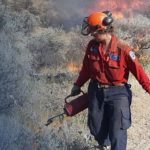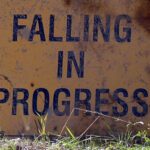Home »

Omitted CAA guideline pivotal and critical
By Chris Conway
A glaring omission in the Jumbo Glacier Resort (GRL) avalanche report could be the final nail in proposed resort’s coffin.
A March 19 risk assessment report by Dynamic Avalanche Consulting determined that GRL’s day lodge and a service building foundations are located in moderate to high risk zones of the Pink Panther avalanche path. The Pink Panther is capable of producing very large, widespread and destructive avalanches.
Then last week (April 24) the Environmental Assessment Office (EAO) found GRL to be non-compliant with a legally binding commitment prohibiting buildings in avalanche hazard zones.
In a letter to the Columbia Valley Pioneer last week (May 1) GRL president Oberto Oberti stated: “the project will not be stopped by games of words; we trust that the Canadian justice system would not permit it and we expect that the legal route will not be necessary.”
According to GRL’s spokesperson Grant Costello, risk mitigation strategies recommended by Dynamic will allow the project to proceed.
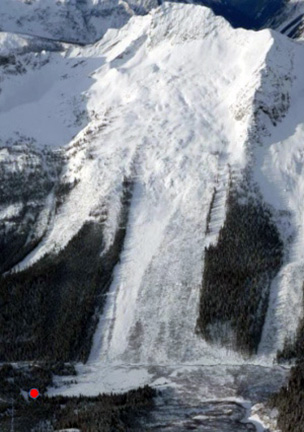
In the letter, Costello quoted Dynamic’s recommendation that “Protection of workers and the public in and around the day lodge will require implementation of an avalanche safety plan which will include explosive avalanche control and an evacuation plan implemented by trained, experienced and licensed avalanche technicians.”
Costello says that a small amendment to the Environmental Assessment Certificate will clear the way for removal of impediments to constructing the day lodge and service building. “We remain determined to complete what we have begun,” he proclaimed.
But a glaring omission in Dynamic’s report may ultimately rule out any future for the day lodge and the entire project.
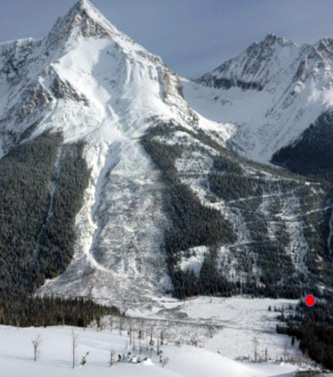
The Dynamic report affirms that the Guidelines for Snow Avalanche Risk Determination and Mapping in Canada CAA, (2002) are the generally accepted guidelines for land development and operations located in avalanche terrain. Dynamic relies upon the guidelines as the basis of the report’s methodology and conclusions.
The CAA guidelines state: “special structures where large numbers of people may gather, multi-unit residences or structures used for essential services (hospitals, schools, police and fire stations) must be placed only in a White zone and where there is a high confidence that the avalanche risk is low.”
This is a significant provision in the CAA guidelines. It virtually slams the door on GRL’s plan to amend the EA Certificate.
The restrictive guideline was omitted from Dynamic’s otherwise detailed report. The result is a misleading conclusion in the report that the CAA guidelines support the day lodge’s current location. It’s reasonable to expect that government would rely on that conclusion. The omitted guideline is pivotal and critical. It’s a very convenient omission for Dynamic’s client and looks more than merely coincidental.
Why did Dynamic miss that? I asked Dynamic’s principal consultant Alan Jones to explain the vital omission from his report; Jones did not respond to the question.
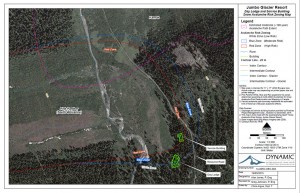
“You are welcome to interpret my report as you wish,” he had previously stated by email.
According to Glacier Resort’s letter the company’s two avalanche consultants (Jones and Schaerer) are “unequivocal in their professional opinions that the day lodge site can be made safe from any avalanche danger with the controls that are ordinarily put in place around the world to ensure public safety.”
Anyone who has been around avalanche experts at all knows that unequivocal absolutism is just not their style. So I contacted the Canadian Avalanche Association for comment on GRL’s statement.
CAA Executive Director Joe Obad responded that a “100% solution” is not terminology typically used by avalanche risk assessment practitioners, who are continually trying to address uncertainty as a component of risk.
“Safety often connotes the absence of risk,” he said. “Complete avalanche safety is generally associated with terrain where there is no possibility of avalanches.”
He also observed that unlike certain professional engineering standards that have the force of legal statute, the CAA guidelines remain just that – guidelines.
Obad says the CAA supports its risk zoning guidelines. “A structure anticipated to be one ‘where large numbers of people may gather’ would typically be restricted to the White zone,” he confirmed. “We recognize the need for our practitioners to apply these guidelines with judgment based on their education and experience,” said Obad. “Where the judgment of a member of the CAA may lead towards a variation from the recommendations of these guidelines, he/she is obliged to present a strong case for doing so.”
For the day lodge project to continue in the current location, GRL must successfully apply to Environment Minister Mary Polak to amend condition 36 of the EA Certificate.
To achieve an amendment GRL’s professional avalanche consultants will need to strongly justify a departure from the CAA’s restrictive guideline. Quietly omitting it is not sufficient. Undoubtedly the entire avalanche industry will take a close critical interest in what they have to say.
But before any of that occurs, Minister Polak must determine if the non-compliant foundations constitute a substantial start on the project. That decision is expected by June.
In making her decision Minister Polak will need to assess if there is any possible future for the day lodge where it now sits. If not, the foundation slab will have to be removed and the site remediated. That’s not a substantial start; it’s a substantial mess and a substantial liability.
The minister will rely on Dynamics report to inform her decision, but the minister will need to read the CAA guidelines for herself if she intends to be fully informed.
– Chris Conway is a freelance photographer and writer in Invermere. View his photography at ChrisConway.ca

